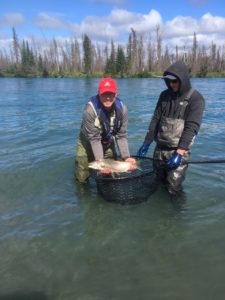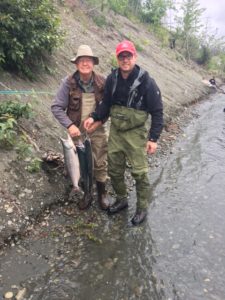I was explaining to Homey that, while the Upper County fishing hike would be one I have wanted to take for some time, I could not join him. I had to be in Alaska during that time.
“What’s this HAVE to be in Alaska business?” “Well, I have to go to the Kenai for sockeye salmon,” I explained. “There are a couple good reasons. First, if I do not get my new nine-weight rig onto the Kenai River, it may never behave properly when I take it elsewhere. Secondly, I go with Homey Bill Boyum and his son, Honorary Homey Jon, the thoracic surgeon. They depend on me for comic relief. I have to go fish in Alaska with them.”
I’m not sure he bought the story, but he did finally acquiesce. Maybe he understood the importance of honoring the tools of our outdoor pursuits. And perhaps the value of tradition and deep friendships. Be that as it may, Alaska called.
We convened a bit over a week ago, on a late Monday night, at Anchorage International Airport. We piled into a simple and significantly overpriced rental car and found our way to a night’s lodging. Early the next morning, we pointed the vehicle more-or-less south, skirting Cook Inlet and moving through forests and mountains toward the town of Soldotna on the Kenai Peninsula.
 The two and a half hour drive took us to our cozy cabin – home for the few days – at Steve and Lea Stuber’s Red Fish Lodge on the Kenai. Since it was too early to check in, we piled our luggage on the office deck, grabbed our gear and headed to a salmon-likely reach of the river.
The two and a half hour drive took us to our cozy cabin – home for the few days – at Steve and Lea Stuber’s Red Fish Lodge on the Kenai. Since it was too early to check in, we piled our luggage on the office deck, grabbed our gear and headed to a salmon-likely reach of the river.
Somewhere in there, Bill reached out to John Wensley, a friend from his early DNR days, now retired from teaching and living over in the town of Kenai. John had a couple suggestions for less crowded fishing.
As you may know, these sockeye do not hit a lure in the traditional sense. It seems a mystery, but somehow a hook with a bit of brightly colored floss bounced along the bottom gets us fish. The sockeye move up the river in relatively shallow channels rarely more than 10 or 12 feet from the gravel bars or shorelines along which we stand. One casts 15 or so feet out, and swings the flossed hook in an arc across the channel. If you hit a snag, but it moves, you attempt to set the hook. Any fish hooked outside the jaw, or behind the gills, is foul-hooked and released. My vision of all this is that the fish snap at our floss as it tickles their noses or jaws and as they “breathe,” moving water over their gills. These are beautiful, shiny, and delicious six to 15-pound red salmon. Once you find the groove, and present your hook successfully, the whole experience is seductive and habit-forming.
We added some new experiences this year. For starters, Dad Bill caught his limit of three salmon before Son Dr. Jon Thinks-Like-A-Salmon for two days in a row – some sort of new record.
 We hired a fishing guide (Alex of Chasing Tales) for a day: partly so we could get to new places and learn new techniques; partly for some trout fishing; and partly to see more of the river. The day yielded limits of salmon and some very enjoyable catch and release trout fishing for Dolly Varden (a char, really) and rainbows up to 16 inches. Somewhere in there, however, Dr. Jon caught a stunning 25-inch, five-pound-plus rainbow. And we all upped our skill levels.
We hired a fishing guide (Alex of Chasing Tales) for a day: partly so we could get to new places and learn new techniques; partly for some trout fishing; and partly to see more of the river. The day yielded limits of salmon and some very enjoyable catch and release trout fishing for Dolly Varden (a char, really) and rainbows up to 16 inches. Somewhere in there, however, Dr. Jon caught a stunning 25-inch, five-pound-plus rainbow. And we all upped our skill levels.
 We hiked in to several new reaches of the river. We never found the crowds (walking by 70 to 80 fishers to find a spot, for example) of past years, but there were still fishers everywhere – easily 1,200 to 1,500 along the Kenai’s banks and islands on any given day.
We hiked in to several new reaches of the river. We never found the crowds (walking by 70 to 80 fishers to find a spot, for example) of past years, but there were still fishers everywhere – easily 1,200 to 1,500 along the Kenai’s banks and islands on any given day.
At one point, Bill and I were working a very productive channel. In walked a young fellow with his apparent squeeze, and as he explained his expertise to her, he walked directly into the channel, and the sockeye moving upstream. I bit my tongue for a short time, but when he moved directly in front of me, within my cast distance, I explained in a quiet, but clear, way that I would not do that to him and he shouldn’t be standing in the fish’s channel, and maybe a couple other things. Bill, fishing on the downstream side of them, was chuckling and tempted to tell them that I was just a cranky old #@$& and he would take me home. As we wrapped up and worked our way to dry ground, I stumbled over a slippery rock and took a wader-filling header – just as we had been noting that none of us fell in this year. Some sort of karmic moment, I suppose.
On our last day, we hiked in to one of our favorite spots with Bill’s old friend John and a fellow teacher, Jeremy. Not wanting to hike our nine salmon back through the woods, Jeremy opted to filet them at the river. He laid the stringer of fish up on the gravel. As he worked on the first two, a speeding boat pushed a big wake up onto the gravel shore, and the seven remaining fish, with stringer, headed down the river – sort of a once-in-a-lifetime experience. During our hike out with our now two fish, we noted that no one got hurt, no one died, and the bears would likely find the fish. Bill mourned the loss of his all-time favorite 69 cent stringer.
Even with that loss, we brought back more than 100 pounds of filets, plans for next year, new friendships, warm memories, and plenty of laughter.
I think that’s why we went.
[Photos of Jon and Jim, and Jon and Alex, by Bill Boyum.]





Jim a friend just sent me this! I’m glad you guys had fun! Hope all is well. If you make it back up give me a call i would like to take you back out.
907-575-3588
Thanks Alex.. Probably back in 2020..